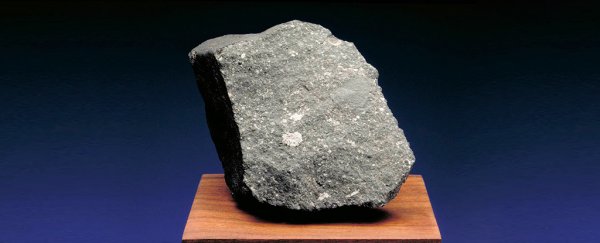It crashed into Earth in 1969, ending an epic journey that had lasted for billions of years, and maybe even much longer than that.
Inside this mysterious space rock – the Allende meteorite, which rained down over Mexican desert in a hail of fiery fragments a half-century ago – scientists have now identified interstellar material that pre-dates our Solar System, and it exists in a form that we didn't know was even possible.
Finding such incredibly ancient matter – traces of stardust from interstellar space, called presolar grains – is rare, but not unheard of.
Only a few weeks ago, a team of scientists announced that presolar grains identified inside another meteorite (which also crashed to Earth in 1969, but in Australia) constituted the oldest known material on the planet, being somewhere between 5 and 7 billion years old.
For comparison, our own Solar System is only about 4.6 billion years old, so we are wandering into some pre-primordial territory here, at least in terms of our own neighbourhood of space.
Now, in a new study led by Washington University in St. Louis, researchers have identified evidence of presolar grains inside a section of the Allende meteorite - and where they were found inside the space rock contradicts what we knew about long-travelled interstellar material like this.
In this instance, the presolar grains identified were composed of silicon carbide (SiC), and they were discovered within an inclusion inside the meteorite called 'Curious Marie' (after Marie Curie).
"What is surprising is the fact that presolar grains are present," says physicist and cosmochemistry researcher Olga Pravdivtseva.
"Following our current understanding of Solar System formation, presolar grains could not survive in the environment where these inclusions are formed."
This Curious Marie chunk of meteorite has turned up noteworthy chemicals before. On this occasion, what's remarkable is that SiC could exist within the chunk, which is otherwise primarily a calcium-aluminium-rich inclusion (CAI): a mineral mix considered to be among the oldest solid substances that formed in the Solar System.
CAIs are thought to have formed in the super-heated conditions of the solar nebula – the scorching concentration of gas and dust that gave rise to the Sun and Solar System, and which should have proven too hot for interstellar stardust to handle.
"It is generally accepted that CAIs formed close to the Sun at temperatures above 1,500 Kelvin, where presolar grains could not survive, and were then transported to other regions of the nebula where the accretion of planetesimals took place," the authors write in their paper.
In experiments, in which the researchers heated up a tiny sample of Curious Marie, they identified noble gas signatures that revealed SiC inside the CAI – an unexpected combination of chemicals, and one which tells us we may have to revise our understanding of what was possible inside the solar nebula.
"Experimentally, it is an elegant work," Pravdivtseva says.
"Then we had a puzzle of noble gas isotopic signatures to untangle. For me, it is like solving a mystery… It was beautiful when all noble gases pointed to the same source of the anomalies – SiC."
The researchers don't know how silicon carbide from another star made its way into these primordial solids like this, but the fact that it did means we need to rethink a few things about chemistry at the beginning of the Solar System.
"Although CAIs, the oldest dated Solar System solids, have been extensively studied, questions still remain regarding the nature and origin of the isotopic anomalies that they carry, their distribution among primitive meteoritic classes and the relationships to other meteoritic components," the researchers write.
The findings are reported in Nature Astronomy.
